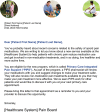A Tool to Identify and Engage Patients on Risky Opioid Regimens
- PMID: 38151042
- PMCID: PMC10752654
- DOI: 10.1055/s-0043-1777126
A Tool to Identify and Engage Patients on Risky Opioid Regimens
Abstract
Background: Concerns around opioid safety for patients living with chronic pain have led to a growing number of collaborative and multimodal pain care initiatives. A major challenge in these efforts has been identifying and engaging patients on high-risk opioid regimens in a timely manner.
Objectives: In this clinical informatics case report, we describe the development and implementation of a web-based tool to support providers as they implement an integrated pain support clinical initiative at primary care clinics across three health care systems.
Methods: The tool identifies patients on risky opioid medication regimens and generates autopopulated patient outreach letters. It contains three core functions that: (1) identify patients prescribed high-dose opioids or coprescribed opioids and benzodiazepines, (2) generate automated letters for patients with an upcoming primary care appointment, and (3) allow clinic staff to write back to a database to track outreach and referrals. Qualitative stakeholder feedback was gathered through interviews and user testing to assess perceived usefulness and ease of use of the tool.
Results: Over a 24-month period, the tool identified 1,125 patients prescribed risky medication regimens and generated 1,315 total letters as some patients became reeligible. Stakeholder feedback revealed that the tool was useful to quickly find patients on risky medication regimens and efficient in generating prepopulated letters that could be mailed in large batches. Additional feedback led to iterative refinements and improved system capabilities that varied across clinics.
Conclusion: Deploying clinical informatics tools that prioritize, engage, and track high-risk patient populations supports reduction of risky medication regimens. Such tools can reduce workload burden on busy primary care staff, particularly during implementation studies, and enhance patient-centered care through the use of direct-to-consumer outreach.
Thieme. All rights reserved.
Conflict of interest statement
None declared.
Figures




References
-
- Centers for Disease Control and Prevention Mortality multiple cause files. 2021. Accessed November 10, 2022 at:www.cdc.gov/nchs/data_access/vitalstatsonline.htm#Mortality_Multiple
-
- Centers for Disease Control and Prevention Provisional drug overdose death counts. 2023. Accessed May 1, 2023 at:https://www.cdc.gov/nchs/nvss/vsrr/drug-overdose-data.htm
-
- Coyle D T, Pratt C Y, Ocran-Appiah J, Secora A, Kornegay C, Staffa J. Opioid analgesic dose and the risk of misuse, overdose, and death: a narrative review. Pharmacoepidemiol Drug Saf. 2018;27(05):464–472. - PubMed
-
- Volkow N D, McLellan A T. Opioid abuse in chronic pain—misconceptions and mitigation strategies. N Engl J Med. 2016;374(13):1253–1263. - PubMed

